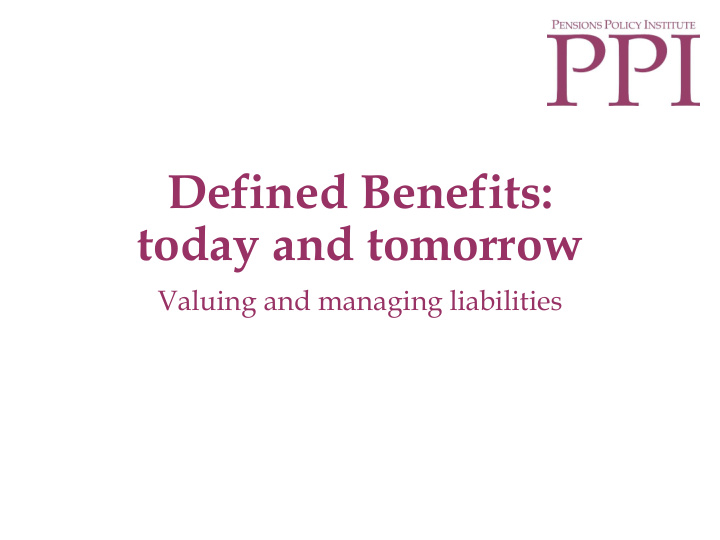



Defined Benefits: today and tomorrow Valuing and managing liabilities
Considerable uncertainty in valuing liabilities Survivors Job tenure Discount rate Salary growth Longevity Inflation Investment returns Interest rates Accounting valuation (FRS102) Funding valuation (SFO) PPF valuation (s179) Valuation Buy-out valuation CETV calculations
Mechanisms for controlling liability growth / volatility Liability management Adjust benefits Scheme closure
Scheme closures and subsequent winding up / PPF entry could reduce number of schemes to 3,500 by 2030 7000 Number of DB pension schemes 6000 Winding up 5000 4000 Close to future accruals 3000 Closed to new members 2000 Open to new members 1000 0 2016 2017 2018 2019 2020 2021 2022 2023 2024 2025 2026 2027 2028 2029 2030
Strategies for reducing liabilities and volatility John Lewis In 2015, the John Lewis Partnership finalised details of changes to their pension scheme Partnership which included a number of initiatives designed to reduce the growth in future liabilities and make the scheme more affordable to the sponsor. These included: • The creation of a new hybrid DC defined contributions and DB benefit structure with partners joining the DB scheme after 5 years’ service; A reduction in the DB accrual rate from 1/60 th to 1/120 th per annum; • A shift from using RPI to CPI (and capping at 2.5%) for future pension increases; • • Linking pension age to the state pension age Diageo In 2017, Diageo announced an agreement with its unions to take forward proposals to a consultation period designed to amend its pension scheme by: • Moving from final salary to career average from April 2018; Moving to a 1/70 th accrual rate and member contributions of 8;% • • Adopting CPI (capped at 5%) rather than RPI for accrued benefits; • Putting new employees into a defined contribution scheme from January 2018 (and before that if they choose DC over DB) Tesco In 2015, Tesco completed its consultation process to close its defined benefit scheme to all future accruals and replace it for future benefits with a defined contribution scheme, in doing so reducing its average contributions from 11% of pay to a maximum of 7.5% for most staff and 11.25 for senior management and reducing the value of liabilities by increasing deferred pensions by CPI rather than RPI.
Green Paper appears to call into question many calls for flexibility “The available evidence does not appear to support the view that these pensions are generally ‘unaffordable’ for employers. While DB pensions are more expensive than they were when they were originally set up, many employers could clear their pension deficit if required. There is also little evidence that scheme funding deficits are driving companies to insolvency, and it seems clear that the majority of employers should be able to continue to fund their schemes and manage the risk their schemes are running.”
Questions for discussion • Is the Green Paper right to suggest that ‘across the board action’ is not needed to relieve pressure on employers? • Are trustees considered in their view on discount rate for funding valuation? • Is there a solution for stressed schemes that minimises the moral hazard? • How should consolidation be driven forward?
Recommend
More recommend